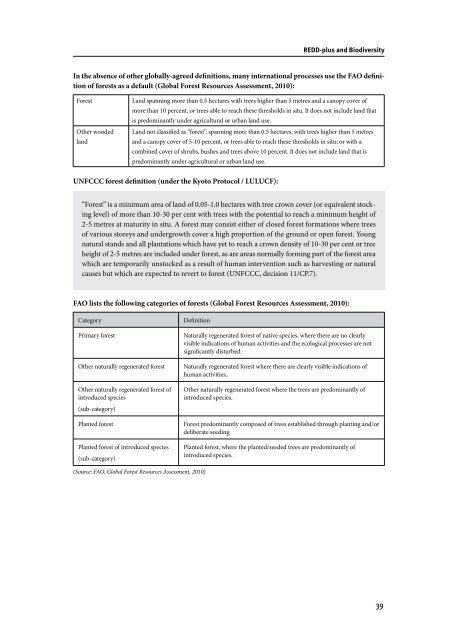REDD-plus and Biodiversity - Convention on Biological Diversity
REDD-plus and Biodiversity - Convention on Biological Diversity
REDD-plus and Biodiversity - Convention on Biological Diversity
Create successful ePaper yourself
Turn your PDF publications into a flip-book with our unique Google optimized e-Paper software.
<str<strong>on</strong>g>REDD</str<strong>on</strong>g>-<str<strong>on</strong>g>plus</str<strong>on</strong>g> <str<strong>on</strong>g>and</str<strong>on</strong>g> <str<strong>on</strong>g>Biodiversity</str<strong>on</strong>g><br />
In the absence of other globally-agreed definiti<strong>on</strong>s, many internati<strong>on</strong>al processes use the FAO definiti<strong>on</strong><br />
of forests as a default (Global Forest Resources Assessment, 2010):<br />
Forest<br />
Other wooded<br />
l<str<strong>on</strong>g>and</str<strong>on</strong>g><br />
L<str<strong>on</strong>g>and</str<strong>on</strong>g> spanning more than 0.5 hectares with trees higher than 5 metres <str<strong>on</strong>g>and</str<strong>on</strong>g> a canopy cover of<br />
more than 10 percent, or trees able to reach these thresholds in situ. It does not include l<str<strong>on</strong>g>and</str<strong>on</strong>g> that<br />
is predominantly under agricultural or urban l<str<strong>on</strong>g>and</str<strong>on</strong>g> use.<br />
L<str<strong>on</strong>g>and</str<strong>on</strong>g> not classified as “forest”, spanning more than 0.5 hectares, with trees higher than 5 metres<br />
<str<strong>on</strong>g>and</str<strong>on</strong>g> a canopy cover of 5-10 percent, or trees able to reach these thresholds in situ; or with a<br />
combined cover of shrubs, bushes <str<strong>on</strong>g>and</str<strong>on</strong>g> trees above 10 percent. It does not include l<str<strong>on</strong>g>and</str<strong>on</strong>g> that is<br />
predominantly under agricultural or urban l<str<strong>on</strong>g>and</str<strong>on</strong>g> use.<br />
UNFCCC forest definiti<strong>on</strong> (under the Kyoto Protocol / LULUCF):<br />
“Forest” is a minimum area of l<str<strong>on</strong>g>and</str<strong>on</strong>g> of 0.05-1.0 hectares with tree crown cover (or equivalent stocking<br />
level) of more than 10-30 per cent with trees with the potential to reach a minimum height of<br />
2-5 metres at maturity in situ. A forest may c<strong>on</strong>sist either of closed forest formati<strong>on</strong>s where trees<br />
of various storeys <str<strong>on</strong>g>and</str<strong>on</strong>g> undergrowth cover a high proporti<strong>on</strong> of the ground or open forest. Young<br />
natural st<str<strong>on</strong>g>and</str<strong>on</strong>g>s <str<strong>on</strong>g>and</str<strong>on</strong>g> all plantati<strong>on</strong>s which have yet to reach a crown density of 10-30 per cent or tree<br />
height of 2-5 metres are included under forest, as are areas normally forming part of the forest area<br />
which are temporarily unstocked as a result of human interventi<strong>on</strong> such as harvesting or natural<br />
causes but which are expected to revert to forest (UNFCCC, decisi<strong>on</strong> 11/CP.7).<br />
FAO lists the following categories of forests (Global Forest Resources Assessment, 2010):<br />
Category<br />
Primary forest<br />
Other naturally regenerated forest<br />
Other naturally regenerated forest of<br />
introduced species<br />
(sub-category)<br />
Planted forest<br />
Planted forest of introduced species<br />
(sub-category)<br />
Definiti<strong>on</strong><br />
Naturally regenerated forest of native species, where there are no clearly<br />
visible indicati<strong>on</strong>s of human activities <str<strong>on</strong>g>and</str<strong>on</strong>g> the ecological processes are not<br />
significantly disturbed.<br />
Naturally regenerated forest where there are clearly visible indicati<strong>on</strong>s of<br />
human activities.<br />
Other naturally regenerated forest where the trees are predominantly of<br />
introduced species.<br />
Forest predominantly composed of trees established through planting <str<strong>on</strong>g>and</str<strong>on</strong>g>/or<br />
deliberate seeding.<br />
Planted forest, where the planted/seeded trees are predominantly of<br />
introduced species.<br />
(Source: FAO, Global Forest Resources Assessment, 2010)<br />
39

















